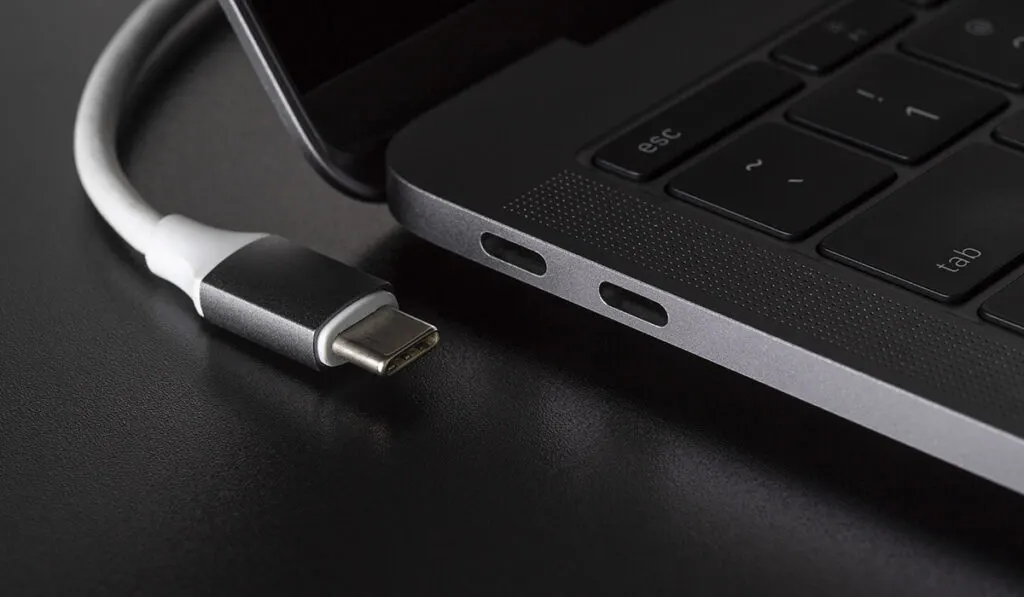Thunderbolt 4 — the latest version of Intel’s popular high-speed data connection technology — is quickly becoming the go-to connection for many devices. But how does it compare to the USB-C cable?
Thunderbolt 4 transfers data at speeds of up to 40 Gbps, while USB-C trails behind at 10 Gbps. Both cables are capable of fast charging and provide up to 100 Watts of power. And while Thunderbolt 4 supports up to two 4K displays, USB-C cables are much cheaper.
As upgrades to their predecessors, both Thunderbolt 4 and USB-C bring some important new features to the table. Here’s a closer look at how the two compare so that you can decide which one’s better for your needs.
What Is a Thunderbolt 4?

Thunderbolt 4 is the fourth generation of Intel’s Thunderbolt data transfer technology. Released in July 2020, Thunderbolt 4 promised to deliver faster data speeds, improved power delivery, and better external display support.
Thunderbolt (initially known as Light Peak) is a high-speed digital data transfer protocol used to connect devices such as computers, monitors, and peripherals to one another. The cables used to connect devices feature a small lightning bolt symbol, which is how the protocol got its name.
Thunderbolt 4 technology increases the data transfer speed and is currently the most powerful and versatile Thunderbolt connection.
How Fast Does a Thunderbolt 4 Transfer Data?
A Thunderbolt 4 cable (on Amazon) is capable of transferring data at speeds of up to 40 Gbps, which is similar to that of Thunderbolt 3 but double that of Thunderbolt 2. This powerful transfer speed is ideal for high-end tasks such as 4K video streaming, gaming, and editing large files.
Evidently, there’s no significant difference in the speed of a Thunderbolt 3 and Thunderbolt 4 when it comes to data transfer. However, the latest iteration of this technology offers better external display support and additional security features.
How Fast Does a Thunderbolt 4 Charge?
Thunderbolt 4 offers a standard 15 watts and up to 100 watts of charging power. To fast charge your device, the power brick with Thunderbolt 4 should have a minimum of 45 watts or more.
With this power, you can expect to charge most devices quickly. The same goes for Thunderbolt 3.
| VERSION | YEAR LAUNCHED | DATA TRANSFER (Gbps) | CHARGING POWER (Watts) |
| Thunderbolt 1 | 2011 | 10 | 10 |
| Thunderbolt 2 | 2013 | 20 | 100 |
| Thunderbolt 3 | 2015 | 40 | 100 |
| Thunderbolt 4 | 2020 | 40 | 100 |
What Is a USB-C?

A USB-C (or USB Type-C) is a 24-pin, reversible-plug connector system used to power and transfer data between devices. It’s the modern version of the well-known USB and was designed to replace all other USB connectors, such as Micro-USB.
USB-C has a distinct oval and symmetrical shape, which makes it easier to insert the plug into its port in any direction. It’s compatible with a wide range of devices, including Nintendo Switch, Windows 10 laptops, Android phones, and tablets.
This makes it possible to connect different devices with a single cable.
How Fast Can a USB-C Transfer Data?
The speed of data transfer on a USB-C cable depends on the protocol it’s using. For example, USB 3.1 Gen 1 can transfer data at up to 5 Gbps, and USB 3.1 Gen 2 can transfer data at up to 10 Gbps.
This is significantly lower than the Thunderbolt connection, but for everyday use, it’s usually more than enough.
How Fast Can a USB-C Charge?
Many devices also support USB Power Delivery (USB-PD), which can provide up to 100W of power. That’s sufficient to charge a laptop or even power some external monitors.
However, it’s important to note that not all USB-C cables are created equal; some may be limited to lower power delivery (2.5W).
The charging speeds and capabilities are similar between Thunderbolt 4 and USB-C, with the main difference being that Thunderbolt 4 supports more power delivery.
What’s the Difference Between Thunderbolt 4 and USB-C?
Now to the main question: What’s the difference between Thunderbolt 4 and USB-C? While both cables have a similar shape, Thunderbolt 4 holds multiple advantages over USB-C.
Data Transfer Speed
One of the main differences between the two connections is the data transfer speed. Thunderbolt 4 supports a faster 40 Gbps transfer rate compared to USB-C, which is limited to 10 only Gbps.
Even if you compare USB-C to Thunderbolt 2, you’ll still get a much faster transfer speed with the latter. The Thunderbolt technology was designed with speed in mind. It is, therefore, perfect for high-end tasks such as gaming or video streaming.
Even so, the 10 Gbps transfer rate of USB-C is more than enough for everyday tasks such as transferring documents and media files. It’s also a major upgrade from the 5 Gbps speed of USB 3.0.
Charging Capability
When it comes to charging capability, both Thunderbolt 4 and USB-C provide up to 100W of power. And unlike the previous Thunderbolt ports, you can now charge devices with either connection.
However, fast charging using a USB-C cable will depend on the type of cable you’re using. Some cables may be limited to lower power delivery, while Thunderbolt 4 should always provide the maximum charging capability.
In the end, it’s basically a tie in this category. You can expect to get the same charging speeds and capability with either connection.
HD Display
Both USB-C and Thunderbolt 4 can be used with 4K displays. But the Thunderbolt technology goes beyond this, allowing you to connect up to two 4K displays (or one 8K display) with a single cable.
This makes it perfect for tasks such as video editing, gaming, and other activities that require a high-resolution display. USB-C, on the other hand, is more suitable for everyday activities that don’t require a lot of graphics power.
Cost
Finally, there’s the cost. Thunderbolt 4 cables offer impressive features and speeds but come with a hefty price tag. This is possibly due to the additional hardware associated with using the technology.
USB-C cables are much cheaper — you can get one for less than $10 (on Amazon). For someone who just needs a single cable to transfer data and charge their devices, it may seem financially more sensible to opt for a USB-C connection.
| VERSION | THUNDERBOLT 4 | USB-C |
| YEAR LAUNCHED | 2020 | 2014 |
| DATA TRANSFER (Gbps) | 10 | 40 |
| CHARGING POWER (Watts) | 100 | 100 |
| COST | $159 | Under $10 |
Which One Do You Need?

The Thunderbolt 4 cable can do everything that a USB-C cable can do, but with more goodies added to it. Some situations may require the extra speed of a Thunderbolt 4, while others may just need the basic USB-C connection.
It all comes down to your individual needs and the type of device you are connecting.
You might opt for Thunderbolt 4 if you:
- Need to transfer high-resolution files such as 4K video or run multiple external displays
- Are running high-end tasks such as gaming or video streaming that require faster transfer speeds
- Have a device compatible with Thunderbolt 4
- Want to fast charge your device
On the other hand, USB-C is an excellent choice if you:
- Don’t need the extra speed of Thunderbolt 4
- Are simply looking to connect everyday devices such as smartphones, external hard drives, or flash drives
- Want to charge your device at the fastest speeds possible
- Are looking for a cheaper cable
It’s clear that Thunderbolt 4 offers many advantages over USB-C, particularly regarding data transfer speed and multi-display support. However, USB-C is still a perfectly viable option that can get the job done. Plus, it’s cheap and easily available.
All in all, it depends on your individual needs and the type of device you’re connecting. Knowing the differences between Thunderbolt 4 and USB-C can help you make a more informed purchasing decision.
Thunderbolt 4 and USB4
Thunderbolt 4 clearly outperforms the USB-C in most categories, making it the ideal choice for high-end tasks. However, a new contender in town promises to be the new gold standard of connectivity: USB4.
Hewlett Packard, Apple, Microsoft, Intel, and other tech giants contributed to the development of USB4, which seeks to be the go-to choice for high-end computing tasks. With its 40 Gbps data transfer speeds and power delivery of up to 100 watts, USB4 should be able to compete with Thunderbolt 4.
But which one is superior? That’s a story for another day.
